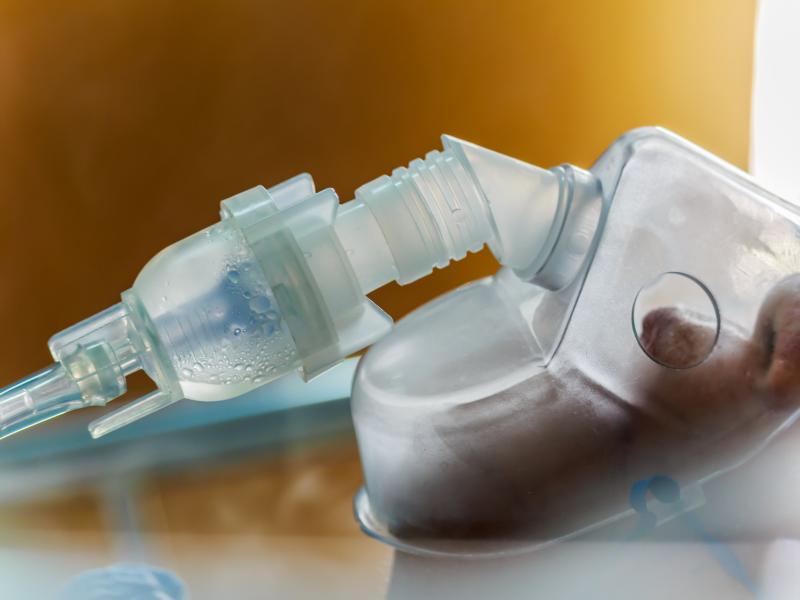
In the management of children hospitalized with severe asthma exacerbations, preservative-free albuterol formulations are safer for use in continuous nebulization compared with a benzalkonium chloride (BAC)-containing formulation, which is associated with longer treatment duration and additional respiratory support, as shown in a recent study.
“BAC is a chemical preservative contained in the 0.5% multidose 20-mL dropper bottle of albuterol. All other albuterol products for nebulization are single-dose sterile, preservative-free vials of concentrate or varying dilutions with saline. There is no preservative-free product available in the 20-mL vial size,” according to the researchers.
“Preparing solutions for continuous nebulization is significantly faster and easier if the larger (20-mL) vial size is used… [However], BAC, by itself, has been shown to cause bronchospasm in patients with asthma in a dose-dependent and cumulative manner,” they added. [J Allergy Clin Immunol 2001;107:68-72]
To determine whether BAC would reduce the therapeutic efficacy of albuterol in children with acute asthma exacerbations, the investigators compared the outcomes of 236 children exposed to BAC and 241 controls who received preservative-free formulations. The primary endpoint of duration of continuous albuterol nebulization was longer by a median of 3 hours in the BAC group (median, 9 vs 6 hours). [Pediatrics 2020;145:e20190107]
Kaplan-Meier estimates revealed that at 24 hours, more patients in the BAC vs control group required continuous nebulization (15.7 percent vs 5.8 percent). This was confirmed in multivariable multivariate Cox regression analysis, where patients in the control group were more likely to stop treatment at any point in time (hazard ratio [HR], 1.79, 95 percent confidence interval [CI], 1.45–2.22; p<0.001).
Additionally, BAC was associated with prolonged respiratory support (median duration, 16 vs 8 hours), and patients who received preservative-free albuterol formulations were more likely to discontinue support at any point in time (HR, 1.43, 95 percent CI, 1.16–1.75; p<0.001).
“An increased duration of … continuous albuterol nebulization use and … respiratory support suggests that patients in the BAC group continued to have respiratory distress, on average, for a substantially longer period of time than patients in the control group,” the researchers explained.
“However, the length of stay did not differ between the two groups despite the significant difference in median continuous albuterol duration. This is probably because of other confounding factors that affect the decision to discharge patients after the end of continuous albuterol administration. This also suggests that the deleterious effects of BAC were temporary and lasted only for the duration of the administration of continuous albuterol,” they continued.
Some practicalities
In an accompanying editorial, Drs Alan Woolf and Shannon Manzi from the Harvard Medical School in Boston, Massachusetts, US, pointed out some practicalities of using a multidose vial with BAC vs individual vials without the preservative for continuous nebulization. [Pediatrics 2020;145:e20193590]
“[T]he work required to produce a concentration of 160 mg of albuterol in 240 mL of 0.9% NaCl would require opening 64 individual unit-dose plastic vials (0.5 or 3 mL). With a standard administration rate of 30 mL per hour, this could require 192 plastic ampules per day for a single patient,” Woolf and Manzi noted.
“[It] is not only a repetitive-motion injury risk, it also is a time-intensive process that can result in delays, which is exactly the reason for the hospital’s switch to multidose bottles that was cited in the article” reporting the outbreak of Burkholderia cepacia in patients that was attributed to multidose bottles of albuterol 0.5% in 1995, they continued. [Ann Intern Med 1995;122:762-766]
In addition, Woolf and Manzi stated that the BAC concentration in the currently available multidose albuterol nebulization solution of 0.01% may be diluted significantly when further prepared for continuous inhalation in 0.9% sodium chloride. This has important implications with regard to the risk of BAC-induced bronchospasm, the threshold derived for which was 300 μg (0.3 mg) in a report that delivered BAC as three inhalations each over 1 to 2 seconds. [Am Rev Respir Dis 1990;141:1405-1408]
“For example, common standard dilutions ranging from 16 mg (3.2 mL) of albuterol 0.5% in 240 mL of 0.9% NaCl to 160 mg (32 mL) of albuterol 0.5% in 240 mL of 0.9% NaCl result in 0.0013 mg/mL (0.00013%) and 0.013 mg/mL (0.0013%) of BAC,” they said.
“Although removing or (more likely) replacing BAC is a laudable goal, it must be balanced with safety and the practicalities of delivering care,” they added.